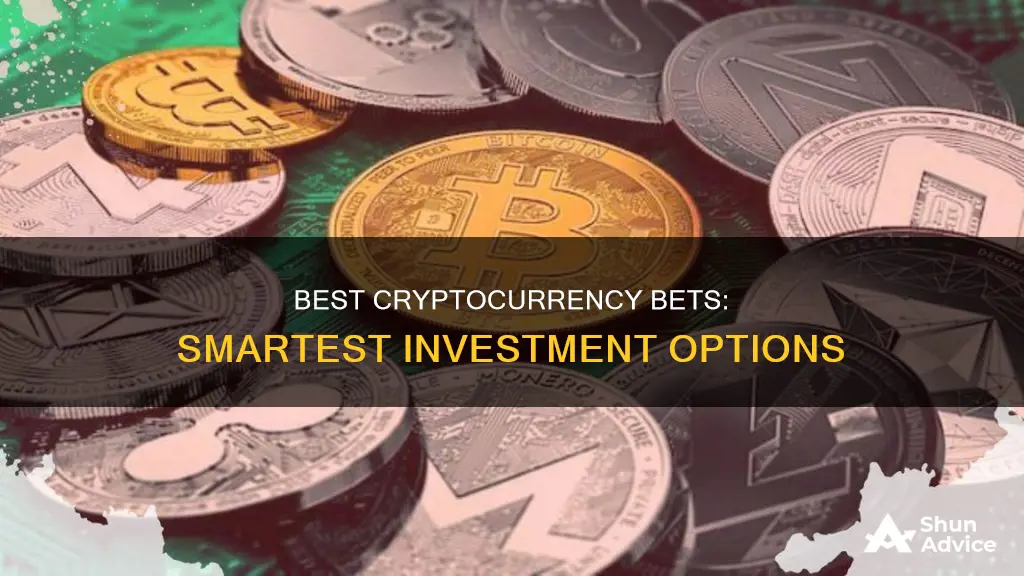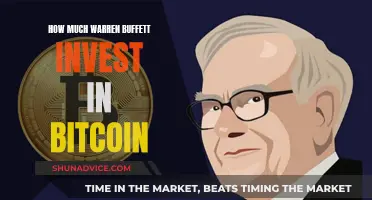
With the crypto market's unpredictability and volatility, it's challenging to pinpoint the smartest cryptocurrency to invest in. Bitcoin, the first and most popular cryptocurrency, has the highest market capitalization and value. However, other cryptocurrencies, like Ethereum, Binance Coin, and Cardano, offer unique features and have gained traction. When deciding where to invest, it's essential to consider factors such as historical data, platform security, transaction speed, and liquidity.
| Characteristics | Values |
|---|---|
| Market Capitalization | $1.2 trillion |
| Year-over-year return | 128% |
| Transaction Speed | Very Fast |
| Transaction Cost | Low |
| Security | High |
| Liquidity | High |
| Investment Risk | High |
| Use Cases | Finance, NFTs, Payment Processing, Gaming |
What You'll Learn

Ethereum: smart contracts and NFTs
Ethereum is a decentralized software platform that enables smart contracts and decentralized applications (dApps) to be built and run without any downtime, fraud, control, or interference from a third party. The goal behind Ethereum is to create a decentralized suite of financial products that anyone in the world can freely access, regardless of nationality, ethnicity, or faith. This makes the platform particularly compelling for people in countries with limited state infrastructure and state identifications, as it can give them access to bank accounts, loans, insurance, and other financial products.
Ethereum uses Ether, its platform-specific cryptographic token, to pay validators who stake their coins for their work on the blockchain, as a payment method off-chain, and as an investment vehicle for speculators. Ether (ETH) is currently the second-largest digital currency by market capitalization after Bitcoin.
Ethereum's blockchain is also the platform on which many decentralized finance (DeFi) and non-fungible token (NFT) applications are built. NFTs are tokens that are individually unique, with different properties and provable scarcity. Each NFT has a number that makes it unique, and there is usually some information (metadata) attached to it, describing what the NFT represents.
Smart contracts are essential to the creation and operation of NFTs. These are self-executing contracts that follow certain rules and are programmed to automatically trigger actions when predetermined conditions are met. For example, a smart contract can be programmed to automatically transfer ownership of an NFT to a buyer once the purchase price has been paid.
The uniqueness of each NFT enables the tokenization of things like art, collectibles, or even real estate, where one specific unique NFT represents a specific unique real-world or digital item. NFTs also allow for the tokenization of non-tangible assets, such as music or social media handles. This gives content creators more power than ever before, as they can sell their work anywhere and access a global market without being bound to a specific company or platform.
Ethereum's blockchain is at the forefront of the development and utilization of smart contracts and NFTs, making it a very attractive investment opportunity.
Skale Coin: A Worthy Investment or Just Another Crypto?
You may want to see also

Tether: stablecoin pegged to fiat currencies
Tether (USDT) is a stablecoin, a type of cryptocurrency that is pegged to a fiat currency, in this case, the US dollar. This means that USDT is designed to maintain a stable value relative to the US dollar, reducing the volatility typically associated with cryptocurrencies. As of March 2024, Tether was the third-largest cryptocurrency overall and the largest stablecoin, with a market capitalization of nearly $99 billion.
Tether was launched in July 2014 and is owned by iFinex, a Hong Kong-registered company that also owns the crypto exchange BitFinex. Tether's USDT is issued on several blockchains, including Ethereum, Avalanche, Kava, and Solana.
The stability of Tether's USDT is underpinned by reserves held by the company. According to Tether, 84.58% of its reserves are held in cash, cash equivalents, short-term deposits, and commercial paper, with the majority of this (76.87%) in US Treasury bills. The remaining reserves are held in corporate bonds, precious metals, bitcoin, secured loans, and other investments. While Tether promotes the idea that every USDT is backed by an equivalent amount of currency, this is not entirely accurate. Nevertheless, Tether has generally honoured its 1-to-1 commitment, allowing investors to redeem USDT for US dollars.
Tether has faced regulatory scrutiny and legal issues, including a settlement with the New York Attorney General in 2021 and a fine from the US Commodity Futures Trading Commission (CFTC) for misleading investors about the extent of its fiat reserves. Despite these controversies, Tether remains widely used and is a popular choice for investors seeking to invest in cryptocurrency while minimising volatility risk.
Tezos Coin: A Smart Investment Decision?
You may want to see also

Binance Coin: native token on Binance exchange
Binance Coin (BNB) is the native token of the Binance exchange, one of the world's leading cryptocurrency exchanges. With a focus on altcoin trading, Binance offers crypto-to-crypto trading in over 350 cryptocurrencies and virtual tokens, including bitcoin (BTC), ether (ETH), litecoin (LTC), dogecoin (DOGE), and its own coin, BNB. Binance was founded in 2017 by Changpeng Zhao, a well-known entrepreneur, investor, and software engineer. Within six months of its launch, the exchange became one of the largest crypto exchanges globally, known for its low transaction fees, high liquidity, and discounts for users paying with BNB.
Binance Coin was initially launched as a utility token in 2017, offering discounted trading fees on the Binance Exchange. However, its utility has expanded, and it can now be used for various applications, including payments for transaction fees on the Binance Chain, travel bookings, entertainment, online services, and financial services. BNB is also the native token of the Binance Smart Chain, which, as of May 2024, processed up to 3.5 million daily transactions, outperforming Ethereum's all-time high.
In terms of market capitalisation, Binance Coin is a major player in the cryptocurrency space. As of July 2023, it was the third-largest cryptocurrency by market capitalisation, valued at around $242.55 per coin, with a market cap of $37.3 billion. As of July 2023, it was the fourth-largest cryptocurrency by market cap, valued at around $250 per coin, with a market cap of approximately $39 billion. More recently, as of May 2024, Binance Coin's market cap had further grown to over $87 billion, placing it behind only Bitcoin, Ethereum, and USD Tether.
It is worth noting that Binance and its CEO, Changpeng Zhao, have faced legal issues, including money laundering charges, which resulted in a settlement of $4.3 billion and Zhao's resignation as CEO in November 2023. Despite this setback, Binance remains a popular cryptocurrency exchange, and BNB continues to be a significant cryptocurrency with a large market cap and a wide range of uses.
EGLD Coin: A Smart Investment Decision?
You may want to see also

Cardano: smaller network, faster and cheaper transactions
Cardano is a blockchain platform that was launched in 2017 and is designed to be a more efficient and secure alternative to existing blockchain platforms. It was developed by Input Output Hong Kong (IOHK), a blockchain research and development company founded by Charles Hoskinson, a co-founder of Ethereum. Cardano uses a layered blockchain to track transactions and store information.
One of the key features of Cardano is its transaction speed. Cardano can process more than 1,000 transactions per second (TPS), which is significantly faster than Bitcoin's transaction speed and comparable to other high-speed blockchain platforms. This speed is achieved through a unique consensus algorithm called Ouroboros, which uses a Proof-of-Stake (PoS) approach. Additionally, Cardano has implemented a number of other features to improve transaction speed, such as its Hydra Layer 2 scaling solution, which enables higher transaction throughput by allowing multiple transactions to occur simultaneously.
Cardano's layered architecture also plays a crucial role in its transaction speed. By separating the settlement and computation layers, Cardano achieves a more efficient and scalable network. This separation allows for parallel processing and optimization of resources, ultimately leading to faster transaction speeds. The introduction of Hydra scaling solutions further enhances Cardano's speed by enabling the network to handle a large number of transactions simultaneously.
Cardano's transaction speed and efficiency are measured through benchmarks such as ADA transaction throughput, including TPS, confirmation time, block size, and network upgrades. Cardano's network efficiency can be evaluated by comparing it with other blockchain technologies, providing insights into its relative performance. When compared with Ethereum, its closest competitor, Cardano demonstrates its effectiveness and performance due to its multi-layered architecture, Ouroboros consensus algorithm, emphasis on interoperability, and rigorous security measures.
Cardano's fee structure also plays a significant role in network efficiency. Cardano aims to provide fast transaction speeds and low fees to its users. The fee structure determines the cost users have to pay for each transaction on the network. By setting appropriate fees, Cardano can incentivize users to make efficient use of network resources, reducing congestion and improving transaction speed.
In conclusion, Cardano offers a smaller network with faster and cheaper transactions compared to other blockchain platforms. Its unique features, such as its layered architecture and Ouroboros consensus algorithm, enable it to provide higher transaction speeds and lower fees. Through continuous development and improvement, Cardano strives to enhance its transaction speed, scalability, and overall user experience.
Catcoin: A Purr-fect Investment?
You may want to see also

Solana: blockchain built for mass adoption
Solana is a blockchain platform that supports decentralized applications (dApps). It is often referred to as an 'Ethereum killer' due to its ability to perform a higher number of transactions per second than Ethereum, at a lower cost.
Solana was founded in 2017 and has since experienced tremendous growth. Its native token, SOL, powers the platform and has seen a significant increase in value since its inception.
Fast and Cheap Transactions:
Solana offers very inexpensive transactions, usually costing less than half a cent, and executing within a second or two. In contrast, Ethereum's gas fees are much higher and fluctuate wildly, often making it uneconomical for small transactions.
Solid and Growing Ecosystem of Tools:
Solana has a wide range of software and hardware tools available for investors, including wallets like Phantom, Backpack, and Solflare, as well as data sources like Birdeye, DexScreener, and CoinGecko. The ecosystem also offers projects that allow coin holders to stake their tokens or lend them to liquidity pools.
The Meme Coin Chain:
Solana is the blockchain where most meme coin projects exist, including popular ones like Dogwifhat and Bonk. It is the preferred venue for meme coin investors due to its minimal fees and fast transaction speeds.
Network Upgrades:
Solana has shown its ability to adapt and improve its network through upgrades. In April 2024, the Solana network was upgraded to process more transactions, addressing issues caused by a frenzy of meme coin trading. This indicates a positive direction for the chain and its commitment to enhancing the user experience.
Risks of Investing in Solana:
While Solana offers many advantages, there are also some risks to consider. Solana has experienced network outages in the past, which can impact prices and developer confidence. Additionally, as a newer blockchain, Solana may face challenges in competing with larger, more established cryptocurrencies.
In conclusion, Solana is a promising investment opportunity with its fast and cheap transactions, solid ecosystem, and popularity among meme coin traders. However, investors should also be aware of the potential risks and volatility inherent in the cryptocurrency market.
Smart Bitcoin Investment: How Much Should You Invest?
You may want to see also
Frequently asked questions
There is no definitive answer to this question as it depends on individual investment goals, risk tolerance, and market conditions. However, some cryptocurrencies that have been highlighted as smart investments include Bitcoin, Ethereum, Binance Coin, Cardano, and Solana.
When choosing a cryptocurrency to invest in, it is important to consider factors such as the speed of transactions, security, adoption rate, liquidity, and the usability of the platform. It is also crucial to understand the risks involved, as the cryptocurrency market is highly volatile.
Investing in cryptocurrencies carries several risks, including high volatility, regulatory issues, scams and fraud, and the potential for hacking or theft. Additionally, the success of a cryptocurrency depends on its widespread adoption, and there is no guarantee that a particular cryptocurrency will gain widespread acceptance.
Cryptocurrencies can be purchased through crypto exchanges such as Coinbase, Kraken, or Gemini. Some brokerages, like WeBull and Robinhood, also allow customers to buy cryptocurrencies. It is important to research the fees, security measures, and reputation of the platform before choosing an exchange or brokerage.







